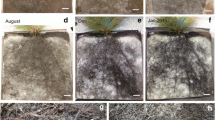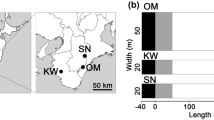Abstract
We attempted to introduce ectomycorrhizal (ECM) fungi onto seedlings of Dipterocarpus alatus (Dipterocarpaceae) by soil inocula collected from tree stands of D. alatus. Top soils collected from beneath the trees of D. alatus in a dry evergreen forest and a 15-year-old plantation were inoculated onto germinating seeds of D. alatus. After 7 months of seedling cultivation, ECM fungal communities in the seedlings were investigated based on the sequences of ITS rDNA. The ECM fungi detected were divided into 19 phylotypes by molecular analysis. Most of the phylotypes were identified as ECM fungal taxa, i.e., Clavulina, Laccaria, Lactarius, Tomentella, Pyronemataceae, and Tricholomataceae. Accordingly, we can confirm that soil inoculation is a simple method to induce ECM formation with diverse fungi in pot cultured seedlings, which would be useful for introducing diverse ECM fungi to dipterocarp plantations.

Similar content being viewed by others
References
Agerer R (1987–2002) Colour atlas of ectomycorrhizae. Einhorn, Schwäbisch Gmünd, Germany
Altschul SF, Madden TL, Schaffer AA, Zhang Z, Zheng Z, Miller W, Lipman DJ (1997) Gapped BLAST and PSI-BLAST: a new generation of protein database search programs. Nucleic Acids Res 25:3389–3402
Avis PG, Charvat I (2005) The response of ectomycorrhizal fungal inoculum to long-term increases in nitrogen supply. Mycologia 97:329–337
Baar J, ter Braak CJF (1996) Ectomycorrhizal sporocarp occurrence as affected by manipulation of litter and humus layers in Scots pine stands of different age. Appl Soil Ecol 4:61–73
Boontawee B (2001) The status of in situ and ex situ conservation of Dipterocarpus alatus Roxb. in Thailand. In: Thielges BA, Sastrapradja SD, Rimbawanto A (eds) Proceedings of the international conference on ex situ and in situ conservation of commercial tropical trees. Yogyakarta, Indonesia, pp 171–181
Bray RH, Kurtz LT (1945) Determination of total organic and available form of phosphorus in soil. Soil Sci 59:39–45
Brearley FQ (2006) Differences in the growth and ectomycorrhizal community of Dryobalanops lanceolata (Dipterocarpaceae) seedlings grown in ultramafic and non-ultramafic soils. Soil Biol Biochem 38:3407–3410
Brearley FQ (2011) The importance of ectomycorrhizas for the growth of dipterocarps and the efficacy of ectomycorrhizal inoculation schemes. In: Rai M, Varma A (eds) Diversity and biotechnology of ecto-mycorrhizae. Springer, Berlin, pp 3–17
Brearley FQ, Press MC, Scholes JD (2003) Nutrients obtained from leaf litter can improve the growth of dipterocarp seedlings. New Phytol 160:101–110
Brearley FQ, Proctor J, Suriantata, Nagy L, Dalrymple G, Voysey BC (2007a) Reproductive phenology over a 10-year period in a lowland evergreen rain forest of central Borneo. J Ecol 95:828–839
Brearley FQ, Scholes JD, Press MC, Palfner G (2007b) How does light and phosphorus fertilization affect the growth and ectomycorrhizal community of two contrasting dipterocarp species? Plant Ecol 192:237–249
Brundrett MC (2009) Mycorrhizal associations and other means of nutrition of vascular plants: understanding global diversity of host plants by resolving conflicting information and developing reliable means of diagnosis. Plant Soil 320:37–77
Brundrett M, Bougher N, Dell B, Grove G, Malajczuk N (1996) Working with mycorrhizas in forestry and agriculture. Australian Centre for International Agricultural Research, Canberra
Changtragoon S (2001) Evaluating genetic diversity of Dipterocarpus alatus genetic resources in Thailand using isozyme gene markers. In: Thielges BA, Sastrapradja SD, Rimbawanto A (eds) Proceedings of the international conference on ex situ and in situ conservation of commercial tropical trees. Yogyakarta, Indonesia pp 349–354
Colwell RK (2005) EstimateS: Statistical estimation of species richness and shared species from samples. Version 7.5. User’s Guide and application published at: http://purl.oclc.org/estimates
Gardes M, Bruns TD (1993) ITS primers with enhanced specificity for basidiomycetes: application to the identification of mycorrhizae and rusts. Mol Ecol 2:113–118
Ingleby K, Thuy LTT, Phong NT (2000) Ectomycorrhizal inoculum potential of soils from forest restoration sites in South Vietnam. J Trop For Sci 12:418–422
Jackson ML (1965) Soil chemical analysis-advance course. Department of Soils, University of Wisconsin
Kaewgrajang T, Sangwanit U, Iwase K, Kodama M, Yamato M (2013) Effects of ectomycorrhizal fungus Astraeus odoratus on Dipterocarpus alatus seedlings. J Trop For Sci 25:200–205
Kettle CJ (2010) Ecological considerations for using dipterocarps for restoration of lowland rainforest in Southeast Asia. Biodivers Conserv 19:1137–1151
Khemnark C (1987) Study on inoculation of ectomycorrhizal fungi on Pinus kesiya in Thailand. Thail J For 6:1–17
Koide RT, Fernandez C, Petprakob K (2011) General principles in the community ecology of ectomycorrhizal fungi. Ann For Sci 68:45–55
Lee SS, Alexander IJ (1994) The response of seedlings of two dipterocarp species to nutrient additions and ectomycorrhizal infection. Plant Soil 163:299–306
Lee SS, Lapeyrie FF, Yazid SM (1995) Techniques for controlled ectomycorrhizal inoculation of dipterocarp seedlings and cuttings. In: Supriyanto, Kartana JT (eds) Proceedings of the second symposium on biology and biotechnology of mycorrhizae and third Asian conference on mycorrhizae (ACOM III), BIOTROP Special Publication 56, SEAMEO BIOTROP, Bogor, Indonesia, pp 217–221
Lee SS, Patahayah M, Chong WS, Lapeyrie F (2008) Successful ectomycorrhizal inoculation of two dipterocarp species with a locally isolated fungus in peninsular Malaysia. J Trop For Sci 20:237–247
Lilleskov EA, Bruns TD (2001) Nitrogen and ectomycorrhizal fungal communities: what we know, what we need to know. New Phytol 149:154–158
Lilleskov EA, Fahey TJ, Horton TR, Lovett GM (2002) Belowground ectomycorrhizal fungal community change over a nitrogen deposition gradient in Alaska. Ecology 83:104–115
Nara K, Nakaya H, Wu B, Zhou Z, Hogetsu T (2003) Underground primary succession of ectomycorrhizal fungi in a volcanic desert on Mount Fuji. New Phytol 159:743–756
Ogawa M (2006) Inoculation methods of Scleroderma columnare onto dipterocarps. In: Suzuki K, Ishii K, Sakurai S, Sasaki S (eds) Plantation technology in tropical forest science. Springer, Japan, pp 185–197
Peay KG, Kennedy PG, Davies SJ, Tan S, Bruns TD (2010) Potential link between plant and fungal distributions in a dipterocarp rainforest: community and phylogenetic structure of tropical ectomycorrhizal fungi across a plant and soil ecotone. New Phytol 185:529–542
Phengklai C, Niyomdham C (1999) The Dipterocarpaceae of Thailand. Proceedings on Dipterocarpus alatus Roxb. and Dipterocarpaceae, vol III. Kasetsart University, Bangkok, Thailand, 17–18 November 1999, pp 131–132
Phosri C, Põlme S, Taylor AFS, Kõljalg U, Suwannasai N, Tedersoo L (2012) Diversity and community composition of ectomycorrhizal fungi in a dry deciduous dipterocarp forest in Thailand. Biodivers Conserv 21:2287–2298
Razavidarbar S, Lakzian A (2007) Evaluation of chemical and biological consequences of soil sterilization method. Casp J Env Sci 5:87–91
Riviere T, Diedhiou AG, Diabate M, Senthilarasu G, Natarajan K, Verbeken A, Buyck B, Dreyfus B, Bena G, Ba AM (2007) Genetic diversity of ectomycorrhizal Basidiomycetes from African and Indian tropical rain forests. Mycorrhiza 17:415–428
Sakai C, Subiakto A, Nuroniah HS, Kamata N, Nakamura K (2002) Mass propagation method from the cutting of three dipterocarp species. J For Res 7:73–80
Sangwanit U, Sangthian T (1991) Ectomycorrhizae of Dipterocarpus alatus Roxb. In: Proceedings of Pre-workshop of BIO-REFOR. Bogor, Indonesia, pp 45–57
Sirikantaramas S, Sugioka N, Lee SS, Mohamed LA, Lee HS, Szmidt AE, Yamazaki T (2003) Molecular identification of ectomycorrhizal fungi associated with Dipterocarpaceae. Tropics 13:69–77
Smith SE, Read DJ (2008) Mycorrhizal symbiosis, 3rd edn. Academic, San Diego
Tedersoo L, Nara K (2010) General latitudinal gradient of biodiversity is reversed in ectomycorrhizal fungi. New Phytol 185:343–348
Thompson JD, Gibson TJ, Plewniak F, Jeanmougin F, Higgins DG (1997) The ClustalX windows interface: flexible strategies for multiple sequence alignment aided by quality analysis tools. Nucleic Acids Res 24:4876–4882
Turjaman M, Tamai Y, Segah H, Limin SH, Cha JY, Osaki M, Tawaraya K (2005) Inoculation with the ectomycorrhizal fungi Pisolithus arhizus and Scleroderma sp. improves early growth of Shorea pinanga nursery seedlings. New For 30:67–73
Turjaman M, Tamai Y, Segah H, Limin SH, Osaki M, Tawaraya K (2006) Increase in early growth and nutrient uptake of Shorea seminis inoculated with two ectomycorrhizal fungi. J Trop For Sci 18:243–249
Turner IM, Brown ND, Newton AC (1993) The effect of fertilizer application on dipterocarp seedling growth and mycorrhizal infection. For Ecol Manag 57:329–337
Yazid SM, Lee SS, Lapeyrie FF (1994) Growth stimulation of Hopea spp. (Dipterocarpaceae) seedlings following mycorrhizal inoculation with an exotic strain of Pisolithus tinctorius. For Ecol Manag 67:339–343
Yuwa-Amornpitak T, Vichitsoonthonkul T, Tanticharoen M, Cheevadhanarak S, Ratchadawong S (2006) Diversity of ectomycorrhizal fungi on Dipterocarpaceae in Thailand. J Biol Sci 6:1059–1064
Acknowledgments
We thank the Dean of the Faculty of Forestry, Kasetsart University, Bangkok, who provided the forest nursery and soil sampling sites in Wang Nam Khiew Training Camp, and the head of Sakaerat Silvicultural Research Station in the Royal Forest Department who provided the soil sampling site in the plantation. This study was supported by the Global Center of Excellence Program “Advanced utilization of fungus/mushroom resources for sustainable society in harmony with nature” from the Ministry of Education, Culture, Sports, Science, and Technology of Japan. We also thank the editor and two anonymous reviewers for their valuable comments on the manuscript.
Author information
Authors and Affiliations
Corresponding author
Electronic supplementary material
Below is the link to the electronic supplementary material.
10310_2013_408_MOESM1_ESM.tif
Ectomycorrhizal roots of Dipterocarpus alatus induced by soil inocula collected from stands of D. alatus: a morphotype 1; b cross-section of morphotype 1; c morphotype 2; d cross-section of morphotype 2; e morphotype 3; f cross-section of morphotype 3 (M mantle, arrowhead Hartig net, white bar 400 μm, black bar 10 μm) (TIFF 6189 kb)
About this article
Cite this article
Kaewgrajang, T., Sangwanit, U., Kodama, M. et al. Ectomycorrhizal fungal communities of Dipterocarpus alatus seedlings introduced by soil inocula from a natural forest and a plantation. J For Res 19, 260–267 (2014). https://doi.org/10.1007/s10310-013-0408-z
Received:
Accepted:
Published:
Issue Date:
DOI: https://doi.org/10.1007/s10310-013-0408-z




